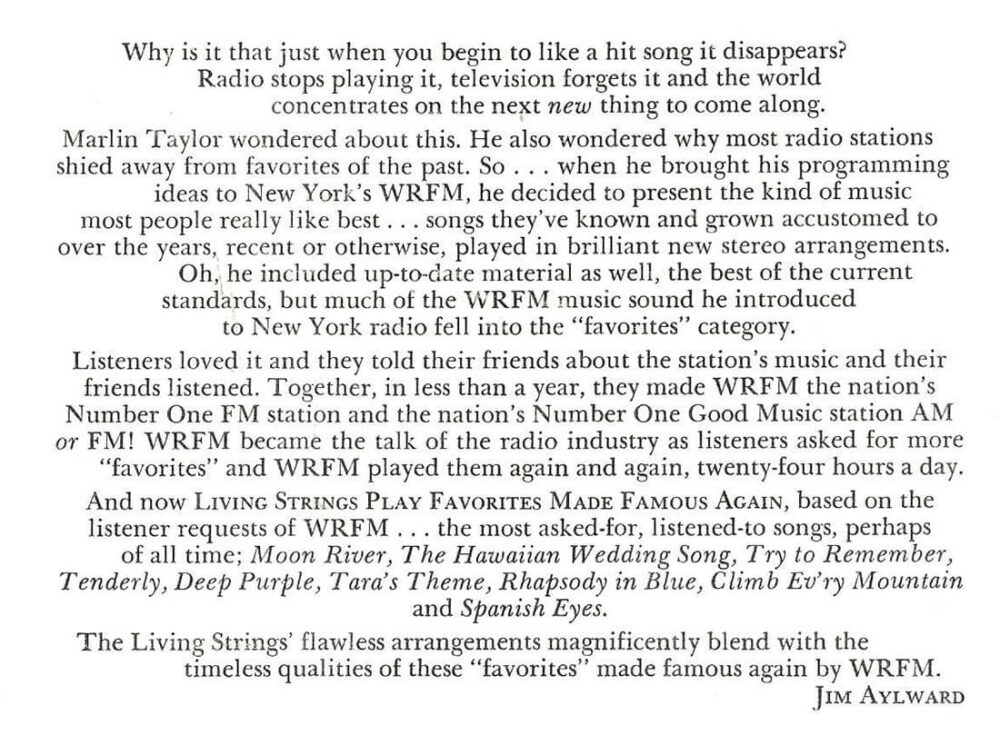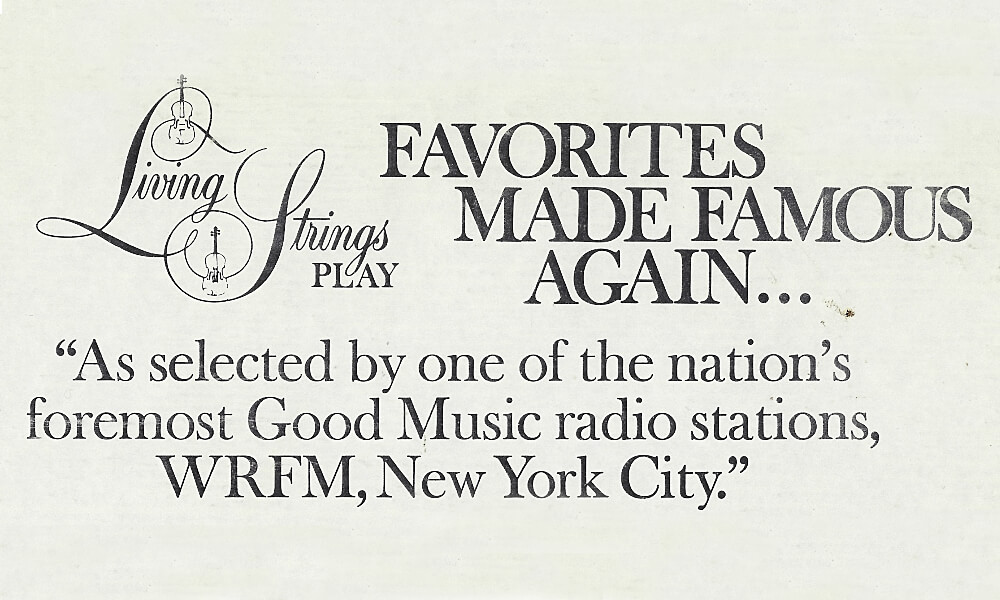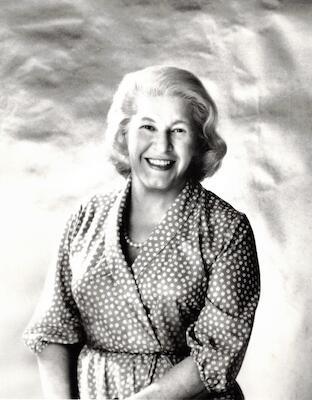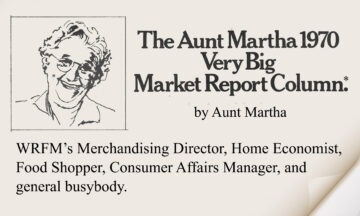… especially as related to “our kind of music,” Easy Listening /Beautiful Music … passed away recently. Her name was Ethel Gabriel, a name unfamiliar to many. While she racked up many credits in her 44 years with RCA Victor, a landmark action was the creation of the Living series of albums which, for the most part, were instrumental string versions of popular melodies.
The series began in 1959 and soon gained popularity with record buyers. So, she produced additional recordings, working primarily with English conductor-arrangers. As sales grew, she broadened from the Living Strings to include the Living Voices, Living Marimbas, Living Guitars, and themes such as Music of the Sea. Hence, these recordings became a backbone for the radio format, which I would launch in Philadelphia on WDVR just four years later in 1963, then in 1969 on WRFM in New York … which led to the recording displayed here.
And I felt supremely honored that, following the station’s dramatic acceptance by the music lovers of greater New York, Ethel would honor us in this manner … as we did not pay for this recording — you’ll see from the numbering that it was treated as a regular RCA Camden release.

Looking back, it was pretty obvious from an early age that Ethel Nagy Gabriel was a girl not only with a love of music but with dreams and a goal … and was destined to play a notable role in the music industry. By the time she reached her teens, she was an accomplished trombonist and started her own dance band at age 13.
She grew up just outside of Philadelphia. Upon finishing high school, to help pay for attending Temple University, she landed a job at the RCA Victor plant just across the river in Camden, New Jersey … working in the packaging and testing of recordings. Keep in mind, this was 1940 … recordings were still just 78 RPM discs, and most of the RCA Victor activity was still in Camden, including its main recording studio. In her off time, Ethel would go “next door” and watch recording sessions. It’s said she “practically lived at the sound studios and learned by listening and watching others work.” (This is exactly how yours truly learned the craft of broadcasting.) Eventually, she was made secretary to RCA Victor’s A & R (artists and repertoire) department manager.
In the later 1950s, she was named head of RCA Camden, the company’s budget re-issue label, which was close to folding. It was thought this would end the career of this woman who was infringing on the “man’s world” of the music industry. Instead, as is obvious, she went on to rejuvenate it — beginning with the Living series — transforming the Camden label into a multi-million dollar enterprise in its own right.
Exactly how many albums were released in the Living series, I cannot tell you … yet the total run of this concept series would last 22 years. And, they were by no means the only credits earned by Ethel — she would play a major A & R role in many of the great artists appearing on the RCA label. To name a few … Perry Como, Elvis Presley, Peter Nero, Eddy Arnold, Henry Mancini, Harry Belafonte, Arthur Fiedler & the Boston Pops, Al Hirt, and my friend Roger Whittaker. And, she convinced management to bring the legendary Perez Prado to the U. S. from Mexico and produced his great recording of “Cherry Pink and Apple Blossom White.” It’s said that she had her hand in producing at least, likely, more than 2,500 recordings.
She was finally promoted to Vice-President in RCA’s A & R Department in 1982 but would retire from the company not long after. Music lovers everywhere and we who made our life’s work in programming popular music owe so much to this great lady who used her intuitive senses to create and produce many hundreds of great recordings!
Her true claim to fame: Ethel was the first woman record producer for a major record label, and one of the first women in the world to work in A & R!
When Ethel passed in late March, she — like the recent death of Prince Philip of Great Britain — was just months shy of achieving the century mark.

Now to tie it all together: The name Jim Aylward is best remembered as a popular morning personality on WRFM. Prior to that … not long after I took on the management of the station, I brought Jim on board to handle publicity and public relations. A short time later he began writing and voicing a regular weekend feature, many with a tongue-in-cheek slant.
Here are the liner notes as they appear on the back of the album … authored by Jim. This was by no means the first album for which he wrote liner notes, nor was it the last. This was a long-term relationship where Jim wrote the liner notes for dozens of RCA label albums … writing was his greatest strength. He even has two children’s books to his credit: “You’re Dumber in the Summer” and “Your Burro Is No Jackass! And over 100 Other Things No One Ever Tells You.”

As for this album, I believe Ethel produced it out of kindness to Jim Aylward, resulting from their longtime relationship. We at WRFM never signed any kind of contract, nor did we ever pay anything for its manufacture. Nor did I ask Ethel or anyone else at RCA to create this album.
As you can see from reading the song title information below, many of the tracks were under the baton of Johnny Douglas, the most utilized of the conductor-arrangers of the Living Strings series. Of course, it’s apparent that this is a compilation of selections recorded and included in earlier releases. While this was a WRFM promotional album, at the same time, it was — as the number at the top of the cover above shows — a general release in the RCA Camden catalog.

In this listing, three names made regular appearances within the Living series: Bernard Ebbinghouse, Geraldo, and Hill Bowen.
Ethel Nagy Gabriel, a true Giant in the music industry … which is filled with individuals who think they are giants along with thousands of wannabe’s … whom the New York Times calls “a Rare Woman in the Record World!”
Thank you, Ethel, for bringing joy to the lives of millions through the hundreds of musical recordings you produced and inspired!
Image Credits: Ethel Nagy Gabriel courtesy of Rochester Democrat And Chronicle Obituaries





Why did instrumental music go out of favor with audiences and when?
Peter, the music, the format did not go out of favor with listeners … when stations began dropping the format in the late 80’s/early 90’s, there was a great outcry, much crying and gnashing of teeth. It was about age of audience and ad agencies having opinion that any listeners over 50 weren’t worth advertising to, so that portion of a station’s audience in the ratings was discounted – causing many stations to lose revenue. Hence, change format to a younger demo targeted format, listeners be damned. When EZ101/WDVR Philadelphia changed format and the telephones began to ring, Dave Kurtz, the founder and principal owner became a virtual basket case … he was so upset by what his station did to their thousands of devoted listeners.
Likewise, other "senior appeal" radio formats have fallen by the wayside as advertisers seek a more youthful audience. Fortunately, Internet Radio has salvaged these formats for all to enjoy once again. It was once explained to me about the difference between playing your favorite music from your own source as opposed to listening to it via a radio presentation. The difference is the surprise of what comes next.
I knew her name well from the back of those thinly jacketed RCA Camden albums. Living Strings. Living Guitars. Living Jazz. Living Trio. Living Marimbas. Living Pianos. Living Brass. Living Voices. Plus trombone. Plus Two Pianos. Plus Harp. Plus Organ. Plus Trumpet. And most of all, the never released Living Banjos.